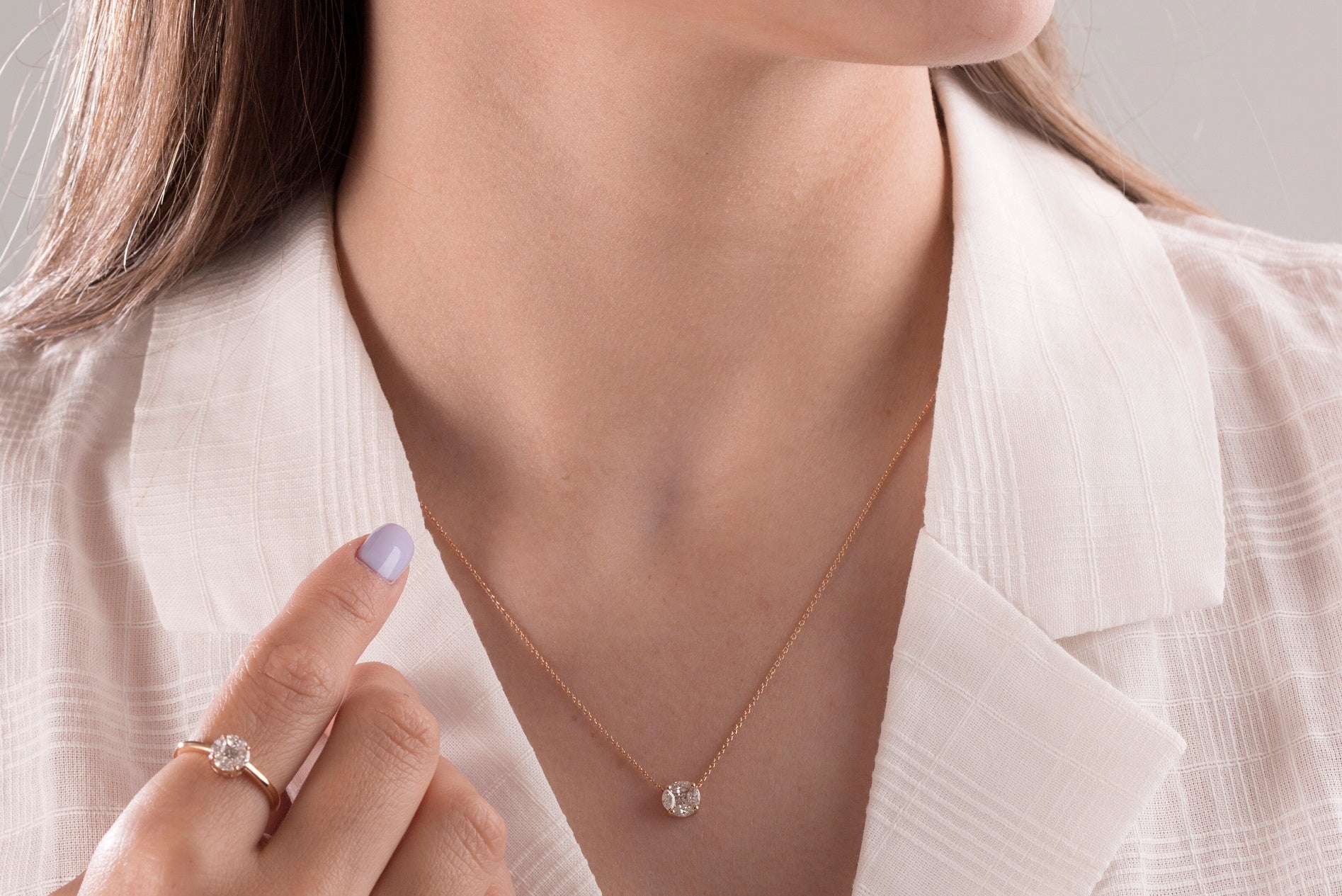When it comes to purchasing a diamond, one of the most important factors to consider is the diamond cut. Diamond cuts not only influence the appearance of the gemstone but also affect its overall brilliance, sparkle, and how it interacts with light. Understanding diamond cuts can help you make an informed decision when choosing a diamond for an engagement ring, pendant, or any other jewelry piece. In this article, we will explore what diamond cuts are, why they matter, and the various types of cuts available to consumers.
What Are Diamond Cuts?
Diamond cuts refer to the way a diamond has been shaped and faceted. Unlike the diamond’s shape, which refers to its general form (such as round, square, or oval), the cut refers to how well the diamond has been crafted. The quality of the diamond cut plays a crucial role in determining the stone’s brilliance, fire, and scintillation. A well-cut diamond will reflect light more effectively, creating a dazzling sparkle that catches the eye. A poor diamond cut, on the other hand, can result in a dull or lifeless appearance, no matter how high-quality the diamond is in terms of color and clarity. When considering diamond cuts, it’s essential to prioritize quality to ensure the diamond will shine as brightly as possible.
The Role of Diamond Cuts in Brilliance and Sparkle
One of the primary reasons diamond cuts are so important is because they significantly affect the diamond’s brilliance and sparkle. Brilliance refers to the amount of white light a diamond reflects, while sparkle (or scintillation) describes the flashes of light that are visible as the diamond moves. A well-cut diamond allows light to enter the stone and reflect off its facets in a way that maximizes these effects. This is achieved through the precise angles and proportions of the diamond’s cut. If a diamond is cut too shallow or too deep, it can cause light to escape from the bottom or sides, resulting in a dull appearance. Therefore, when considering diamond cuts, ensure that the proportions are ideal to achieve maximum brilliance and sparkle.
The Four Cs and Diamond Cuts
When purchasing a diamond, the Four Cs – cut, color, clarity, and carat weight – are essential factors to consider. While color, clarity, and carat weight often get a lot of attention, the cut is arguably the most important factor in determining a diamond’s beauty. A diamond’s cut affects how well it performs in terms of reflecting light, which ultimately impacts its overall appearance. When looking at the Four Cs, it’s important to remember that a diamond’s cut is graded separately from its shape. The cut grade ranges from excellent to poor, with an excellent cut being the ideal for achieving maximum brilliance. Diamonds with an excellent cut are usually more expensive, but the investment is worth it for the added beauty.
Types of Diamond Cuts
There are several different types of diamond cuts, each with its own unique shape and style. The most popular and traditional cut is the round brilliant cut, which is known for its exceptional sparkle and brilliance. This cut features 58 facets, which are carefully arranged to optimize light reflection. Other popular diamond cuts include the princess cut, oval cut, emerald cut, cushion cut, and pear cut. Each of these cuts has its own characteristics, with some emphasizing brilliance and others focusing on shape. For example, the princess cut is known for its modern look and sharp corners, while the cushion cut has rounded edges and a vintage appeal. When choosing a diamond, it’s essential to consider both the cut and the shape to determine which one best suits your preferences.
Factors Affecting Diamond Cuts
Several factors influence the quality of a diamond cut. These factors include the diamond’s proportions, symmetry, and polish. Proportions refer to the relationship between the diamond’s height, width, and depth, as well as the angles at which the facets are cut. If the proportions are well-balanced, the diamond will reflect light effectively. Symmetry refers to how evenly the facets are aligned, which can impact the diamond’s overall beauty. A well-symmetrical diamond will reflect light uniformly, creating a more consistent sparkle. Lastly, polish refers to the smoothness of the diamond’s surface. A diamond with a high polish will reflect light better, contributing to its overall brilliance. All of these factors combined contribute to the final quality of the diamond cut.
How to Choose the Best Diamond Cut for You
When choosing a diamond cut, it’s important to consider your personal preferences, as well as your budget. Different cuts can have different price ranges, with round brilliant cuts typically being the most expensive due to their complex cutting process. However, diamonds with other cuts, such as the princess or cushion cut, can offer similar brilliance at a lower cost. Another consideration is the style of jewelry in which the diamond will be set. For example, a round diamond cut might be ideal for a classic solitaire engagement ring, while a pear-shaped diamond cut might be better suited for a more modern or vintage design. Ultimately, the best diamond cut for you will depend on your individual taste and the setting in which the diamond will be placed.
Diamond Cut Grades and Their Importance
When evaluating diamond cuts, it’s essential to pay attention to the grading system. Diamond cuts are graded on a scale that typically ranges from Excellent to Poor. An Excellent cut is the highest grade and signifies that the diamond has been cut to ideal proportions, maximizing its brilliance and sparkle. A Good cut indicates that the diamond reflects most of the light but may not have the same level of brilliance as an Excellent cut. Fair and Poor cuts, on the other hand, are usually less desirable because they fail to optimize the diamond’s light performance. When shopping for a diamond, prioritize diamonds with a high cut grade, as this will have the most significant impact on the stone’s appearance and overall beauty.
The Impact of Diamond Cut on Value
The quality of a diamond cut can have a significant impact on its value. A diamond with an excellent or ideal cut will generally command a higher price because it offers superior brilliance and sparkle. In contrast, a diamond with a poor cut will be less expensive but will lack the visual appeal that many buyers desire. When shopping for man made diamonds, it’s important to strike a balance between cut quality and the other Cs – color, clarity, and carat weight. While the cut is crucial, other factors such as size and color may also play a role in determining the diamond’s overall cost.
Conclusion: The Importance of Diamond Cuts
In conclusion, diamond cuts play a crucial role in determining the beauty, brilliance, and value of a diamond. Whether you are purchasing an engagement ring, a necklace, or any other piece of diamond jewelry, understanding the significance of diamond cuts can help you make a more informed choice. The cut influences how a diamond interacts with light, impacting its sparkle and overall appeal. From round brilliant cuts to princess cuts, there are various options to suit different styles and preferences. By choosing a high-quality diamond cut, you can ensure that your diamond will remain a stunning symbol of beauty for years to come.

 Why Civil Construction Companies Are the Best Choice for Developing School Facilities
Why Civil Construction Companies Are the Best Choice for Developing School Facilities  Immigration Lawyer in San Antonio: Expert Legal Assistance for Your Immigration Needs
Immigration Lawyer in San Antonio: Expert Legal Assistance for Your Immigration Needs  Diamond Initials: A Personal Touch to Luxury with Lab Created Diamonds
Diamond Initials: A Personal Touch to Luxury with Lab Created Diamonds  The Timeless Elegance of the Oval Diamond Ring with Man Made Diamonds
The Timeless Elegance of the Oval Diamond Ring with Man Made Diamonds  The Timeless Allure of Pear Diamond Engagement Rings
The Timeless Allure of Pear Diamond Engagement Rings  Sparkle with Purpose: The Beauty and Value of Lab Grown Diamond Earrings
Sparkle with Purpose: The Beauty and Value of Lab Grown Diamond Earrings  The Importance of Sod Installation and Choosing the Right Soil for Your Landscape
The Importance of Sod Installation and Choosing the Right Soil for Your Landscape  Diamond Cuts: A Guide to Choosing the Perfect Cut for Your Jewelry
Diamond Cuts: A Guide to Choosing the Perfect Cut for Your Jewelry 



